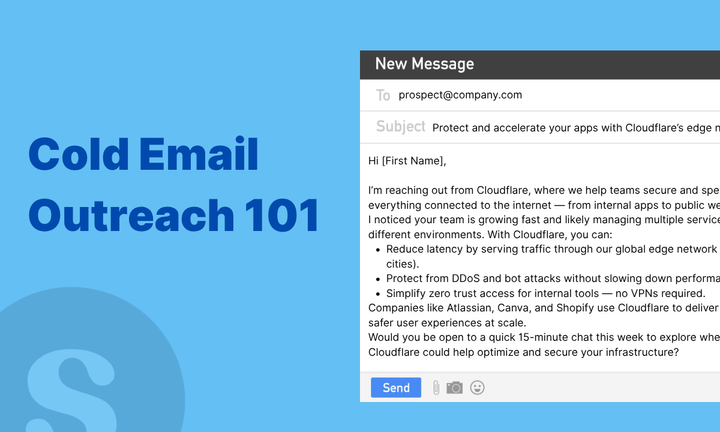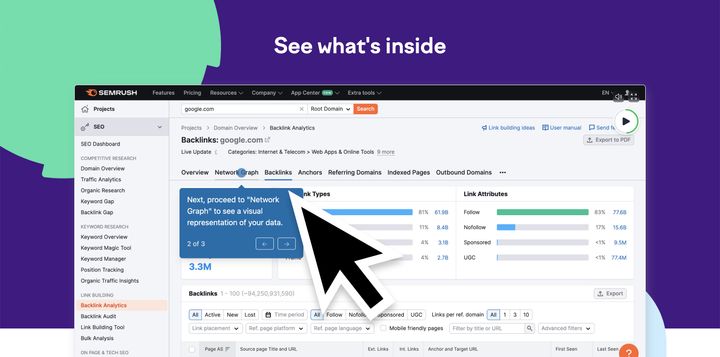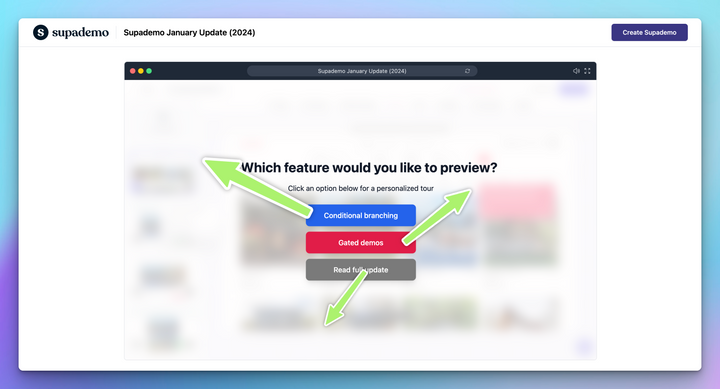Email is, hands down, one of the best outreach channels (although most people will argue against it today).
For every $1 invested, companies see an average return of $38, or 3,800%.
Despite this, reply rates remain stuck at just 4%.
The reason for the massive gap?
With more than 160 billion emails sent daily, most never clear spam filters or grab attention in overflowing inboxes.
So, what is the good news here?
When executed well, cold emailing can still deliver outstanding results. Success depends on knowing what strategies are effective in 2025 and avoiding the mistakes that hold most teams back.
In this guide, we’ll share best practices, ready-to-use templates, and common pitfalls to help you write cold emails that get noticed, earn replies, and book more meetings.
Why cold email works in 2025?
Cold email continues to be one of the most effective outreach channels because it gives you what other platforms can’t: direct access to decision-makers at scale.
Other channels are losing ground
- LinkedIn is flooded with automated pitches that buyers ignore.
- Ads are more expensive every year, forcing you into costly auctions.
- Phone calls rarely connect with the right person.
When combined with good timing, personalization, and strong deliverability, cold email remains the most reliable way to start conversations in 2025.
Tim Watson, a seasoned email marketer, puts it:
Email feels stronger than ever. The smartphone has made it into a 24/7 channel and I’m seeing no shortage of appetite from brands to keep pushing the email channel forward. It simply keeps earning. Email is moving towards a blended approach, combining broadcast, automation and triggers. All driven by behavior-based insight. ‘The money is in the list’ should be changed to the money is in the data.
12 Best practices to write winning cold emails
Knowing why cold email works is only the starting point. The real challenge is writing messages that stand out, get opened, and earn replies in crowded inboxes.
To help, we’ve distilled what works into 12 practical best practices you can apply to every campaign.
1. Write attention-grabbing subject lines
Your subject line is the single biggest factor in whether your email gets opened. No matter how strong your message is, it won’t matter if the subject line doesn’t earn attention.
In 2025, where executives receive hundreds of emails daily and check most of them on mobile, short, clear, and curiosity-driven subject lines consistently outperform long or generic ones.
What works
- Curiosity hooks: Instead of “Follow-up on our platform”, try “Idea for your Q4 pipeline.”
- Timeliness: “Saw your TechCrunch feature” immediately signals relevance.
- Problem-oriented: “Forecasting headaches?” grabs attention by naming a pain.
Actionable steps
- Write at least 3 subject line variations for every email.
- Test them in small batches before scaling.
- Keep a swipe file of subject lines that made you open an email.
- Ask yourself: “Would I open this if I were in their shoes?”
2. Keep your message concise
Long emails don’t get read. Executives skim their inbox in seconds, often on mobile, and anything that looks like work gets ignored. That’s why the best cold emails are short, sharp, and focused on one idea.
What works
- Lead with relevance in the first two sentences.
- Highlight one specific problem or benefit, not your full product pitch.
- Use direct language instead of filler like “I hope this finds you well.”
Actionable steps
- Cap emails at 75–125 words.
- Draft, then cut at least a third to strip away excess.
- Follow a simple arc: context → value → ask.
- Read aloud to test clarity and flow.
3. Personalize beyond the name
Nothing kills a cold email faster than a generic opener like “Dear customer.” Buyers spot templates instantly, and only outreach that feels tailored earns replies. Real personalization means tying your message to a role, company priority, or recent event.
Account-based marketing (ABM) takes this further by tailoring emails to company stage, industry, or strategy, making your outreach intentional instead of automated.
What works
- Referencing a LinkedIn post, blog comment, or press mention.
- Calling out a timely trigger like funding, hiring, or expansion.
- Using ABM to match your message to company context (e.g., startups scaling vs. enterprises integrating).
- Embedding an interactive demo that shows your solution in the prospect’s use case.
Actionable steps
- Spend two minutes scanning for recent triggers before sending.
- Group accounts by stage or industry to build ABM-ready templates.
- Keep a library of strong personalized openers for reuse.
- Add interactive demos to follow-ups to show relevance in action.
4. Lead with relevance, not your pitch
The quickest way to lose a reader is to open with “I’d love to tell you about our product.” Prospects don’t care about features until they see why it matters to them.
Relevance is what earns attention, and it has to come before your pitch. By framing your email around the prospect’s priorities, you create context that makes your solution worth considering.
What works
- Starting with a pain point tied to their role: “RevOps leaders tell me forecasting accuracy is a major challenge right now.”
- Highlighting an industry trend that directly affects them.
- Asking a smart question that reflects their world.
Actionable steps
- Research common role-specific challenges and keep them handy.
- Write your first two sentences about their world, not yours.
- Save product details for later in the email or follow-up.
- Use open-ended questions to spark engagement.
5. Stick to one clear call-to-action
Prospects won’t act if your email leaves them with multiple choices. A cold email should point to a single, simple next step. When you ask for too much—“book a call, try the demo, or read our case study”—the reader does nothing. A focused call-to-action (CTA) makes it easy to say yes.
What works
- Ending with one specific ask: “Would you be open to a 15-minute call next week?”
- Offering two time options to simplify scheduling.
- Using soft CTAs in earlier emails: “Worth sending over a quick case study?”
Actionable steps
- Decide the exact next step before writing your email.
- Make your CTA the final line for visibility.
- Test both hard (book a call) and soft (send more info) CTAs.
- Keep it low-friction—15 minutes is easier to accept than 60.
6. Write like a human
Cold emails that sound like they were written by a sales bot get ignored. Prospects respond to messages that feel natural, conversational, and authentic. Writing like a human makes your email approachable and builds trust before the conversation even starts.
What works
- Using short, clear sentences that mirror how you’d speak.
- Writing in a conversational tone with contractions like “you’re” instead of “you are.”
- Adding a touch of context that feels real: “Saw you’re hiring SDRs—must be a busy quarter.”
Actionable steps
- Read your email out loud; if it sounds stiff, rewrite it.
- Pretend you’re writing to a colleague, not a stranger.
- Keep paragraphs to one or two sentences for readability.
- Use plain language—complex words don’t impress, they alienate.
7. Time your send strategically
Even the best-crafted email can fail if it lands at the wrong time. Timing influences open rates and responses because inboxes are busiest at predictable points in the week. Hitting the right window increases your chances of being seen before your message gets buried.
What works
- Brevo’s research shows 10:00 AM EDT is the global favorite send time, but for SaaS, emails sent on Tuesday or Thursday between 2:00–3:00 PM see the strongest engagement.
- Testing send times with your audience—some industries respond better in the evening or outside standard work hours.

Actionable steps
- Schedule campaigns based on the prospect’s local timezone.
- Use email tools with send-time optimization to experiment.
- Track open and reply rates by time of day and day of week.
- Document what works and replicate it for future campaigns.
8. Warm up your domain
Hitting send is easy. Reaching the inbox is harder. Many teams forget that email providers judge your domain’s reputation before deciding where your message goes.
If you spin up a fresh domain and start blasting hundreds of emails, providers will assume you are spamming and push your outreach straight to junk. Warming up your domain builds trust and gives your campaigns a chance to succeed.
What works
- Setting up authentication records (SPF, DKIM, DMARC) to prove legitimacy.
- Starting small with 20–30 emails per day and ramping up slowly.
- Mixing in manual, natural-looking emails to build credibility.
Actionable steps
- Create a dedicated subdomain for cold outreach.
- Use warming tools or send test emails to colleagues.
- Track deliverability with services like Postmark or GlockApps.
- Increase daily volume gradually over several weeks.
9. Use social proof sparingly
Credibility matters in cold outreach, but flooding an email with client logos or long case studies does more harm than good.
Prospects want to know if you can solve their problem, not read a list of every company you have worked with. One relevant proof point is often enough to build trust.
What works
- Sharing a short, specific result tied to a similar company: “We helped CompetitorX cut onboarding time by 30%.”
- Matching proof to the prospect’s context, such as referencing similar stage startups or well-known enterprises in their industry.
- Framing results in terms of outcomes that matter to the reader, not just features.
Actionable steps
- Pick one proof point that aligns with the prospect’s role or challenge.
- Keep outcomes specific and measurable.
- Save longer case studies or multiple examples for later in the sales process.
- Refresh proof points regularly so they feel timely and relevant.
10. Follow up with purpose
Most replies don’t come from the first cold email. They come after the second or third touch. But sending “just checking in” adds no value and wastes the prospect’s time.
A purposeful follow-up keeps the conversation alive while giving the reader a new reason to engage.
What works
- Adding context with a case study, insight, or industry trend.
- Reframing the problem from a different angle.
- Using a polite “breakup email” as a final touchpoint: “Should I stop reaching out?”
Actionable steps
- Space follow-ups 2–3 business days apart, then weekly.
- Limit sequences to four or five emails unless engagement continues.
- Plan each follow-up with a distinct theme: problem, proof, new angle, final check-in.
- Automate sequences, but write them as if you sent them manually.
10 Battle-tested cold email templates for B2B SaaS
Even with best practices, writing cold emails from scratch can be daunting. That’s where templates help. They give you a proven structure to build on, while still leaving room for personalization.
Below are 10 templates designed specifically for SaaS outreach, complete with context on when to use them and why they get results.
1. The AIDA formula
The AIDA framework (Attention, Interest, Desire, Action) has been used in sales copy for over a century because it mirrors how people make decisions.
This approach works well in SaaS because it lets you grab attention quickly, spark curiosity, show benefits, and end with a clear ask. Use it when introducing your product to a prospect who may not know you yet.
Template:
Subject: Struggling with [pain point]?
Hi [First Name],
Most [role] teams I speak with struggle with [specific challenge].
Our platform helps eliminate that by [one-sentence benefit]. [Customer] used it to [specific measurable result].
Would you like to see how this could work for [Company]?
Best,
[Your Name]
2. The BAB framework
The BAB (Before–After–Bridge) formula focuses on contrast: you highlight the current state (Before), show what life looks like once the problem is solved (After), and position your product as the bridge.
It works because it taps into two powerful motivators—pain avoidance and desire for improvement. Use this when your solution clearly transforms a painful process into an easier one.
Template:
Subject: A better way to [solve pain point]
Hi [First Name],
Right now, [Company] probably spends a lot of time on [problem]. Imagine if [ideal outcome] became your new normal.
That’s what happened for [similar company], who used [product] to [specific result].
Would you be open to a quick call so I can show you what this might look like for your team?
Best,
[Your Name]
3. The interactive demo hook
Sometimes words aren’t enough to convey value. Interactive demos give prospects a quick, hands-on approach to see how your product solves their problem.
Unlike static PDFs or videos, demos are engaging, easy to share with colleagues, and give you visibility into who views them beyond the original recipient. This makes them a powerful cold email asset that both captures attention and signals buying intent.
Template:
Subject: See [problem] solved in 60 seconds
Hi [First Name],
Explaining [problem] over email takes too long, so I recorded a short interactive demo that shows exactly how we help teams like yours. You can view it here: [demo link].
If it looks useful, I’d be glad to walk you through it live.
Best,
[Your Name]
4. The PAS framework
Problem–Agitate–Solution (PAS) is all about urgency. You call out the pain, intensify it by pointing to its costs or risks, then offer your product as the solution. SaaS prospects respond well to PAS because the model makes clear what they stand to lose if they don’t act. Use it when your product addresses an expensive, time-consuming, or risky problem.
Template:
Subject: [Pain point] draining your team?
Hi [First Name],
[Problem] is something most [industry] companies struggle with, and it often costs [stat or resource]. Left unchecked, it creates [negative consequence].
Our platform helps teams avoid this with [specific benefit]. Would you be open to a quick call to walk through how?
Best,
[Your Name]
5. The relevant question
Questions work because they spark curiosity and lower the barrier to reply. But vague questions fall flat—your email must zero in on a challenge your prospect actually faces. By framing your outreach around a specific, relevant question, you invite dialogue instead of pushing a pitch. This works especially well in SaaS when you know the common friction points in your buyer’s role, such as onboarding, reporting, or customer acquisition costs.
Template:
Subject: How are you handling [challenge]?
Hi [First Name],
Many [role] leaders I speak with say [specific challenge] is top of mind. Curious—how are you approaching this at [Company]?
If it helps, I can share how [peer company] tackled this with [solution] and what results they saw.
Best,
[Your Name]
6. The site visitor follow-up
When someone visits your website, they have already shown interest. The goal of this email is not to call out their behavior in a way that feels intrusive, but to acknowledge their curiosity and provide something useful. Pairing the follow-up with a relevant resource or short demo keeps it timely, helpful, and low-pressure.
Template:
Subject: Saw you exploring [page/product]
Hi [First Name],
I noticed you were checking out [specific page or feature] recently. Thought you might find this resource helpful: [link].
We’ve also helped teams like [peer company] use [product] to achieve [specific result]. If it’s useful, happy to show you how it works in a quick call.
Best,
[Your Name]
7. The “better way” template
Prospects often stick with outdated or clunky processes simply because that is what they are used to. This email works by pointing out the inefficiency and showing that there is a simpler, faster, or more cost-effective way forward. In SaaS sales, it is especially effective for highlighting automation, integrations, or workflow improvements that eliminate frustration.
Template:
Subject: A better way to [solve challenge]
Hi [First Name],
[Current method or problem] is time-consuming and takes energy away from more important work. Our platform helps [role/team] achieve [specific result] without the [pain of the old approach].
For example, [peer company] recently switched and reduced [metric] by [percentage].
Would you be open to a quick call to see how this could work at [Company]?
Best,
[Your Name]
8. The resource share
Not every cold email needs to push for a meeting. Sometimes the best way to get on a prospect’s radar is to lead with value. Sharing a relevant article, playbook, or case study positions you as helpful and knowledgeable rather than transactional. This approach works especially well for SaaS buyers in the research phase.
Template:
Subject: Thought this might be useful
Hi [First Name],
I came across this resource on [topic] and thought it might be helpful for your team: [link].
We’ve also worked with companies like [peer company] to [specific benefit], and this approach was a big part of their success. If it resonates, happy to share how they applied it in practice.
Best,
[Your Name]
9. The gatekeeper bypass
Sometimes your email lands in front of someone who is not the decision-maker. Instead of asking, “Who is the right person?” in a generic way, this template acknowledges their role, shows that you’ve done some research, and politely asks to be directed to the right contact. This approach feels respectful and often leads to introductions to the right stakeholder.
Template:
Subject: Who’s best to connect with on [topic]?
Hi [First Name],
I work with [role/team] leaders at [similar companies] to [benefit]. Based on your profile, you may be the right person to discuss this—or you might know who is.
If it makes sense, are you open to a short 10-minute conversation next week? If not, would you mind pointing me in the right direction?
Thanks in advance,
[Your Name]
10. The recent news hook
Trigger events like funding rounds, product launches, or leadership hires create perfect opportunities for outreach. Referencing timely news shows that your email isn’t a generic blast—it’s relevant to what the company is experiencing right now. This approach works because it ties your solution directly to a milestone where new challenges often emerge.
Template:
Subject: Congrats on [recent event]
Hi [First Name],
Congratulations on [mention trigger events like funding, expansion, or product launch]. Big milestones often bring new challenges like [related pain point].
We recently helped [peer company] navigate this stage by [specific result]. Would you be open to a short conversation to see how we might support your team as well?
Best,
[Your Name]
Common mistakes to avoid while cold emailing
Even well-intentioned outreach can fall flat if you fall into these traps. Avoiding these mistakes will save your sender's reputation and increase replies.
- Overloading the email with information: Long paragraphs and multiple asks overwhelm busy readers.
- Relying on generic templates: Copy-paste outreach without personalization gets deleted instantly.
- Using spammy language: Words like FREE or LIMITED TIME trigger filters and hurt deliverability.
- Skipping domain warm-up: Sending from a fresh domain without warming risks every email going to junk.
- Forgetting about timing: Monday mornings and Friday afternoons are the worst times to send.
- No clear call-to-action: Vague closes like “Let me know your thoughts” leave prospects unsure how to respond.
- Ignoring follow-ups: Most replies come after the second or third email, not the first.
- Failing to track engagement: Without data on opens, clicks, or demo views, you’re guessing instead of refining.
- Overusing social proof: Listing too many logos or testimonials looks like bragging, not credibility.
- Writing like a robot: Formal, jargon-heavy language makes your email feel impersonal.
Turn cold emails into qualified conversations with interactive demos
We’ve covered why cold email still delivers results, how to write messages that stand out, and which mistakes to avoid. You now have practical frameworks and templates to help you earn replies in crowded inboxes.
To take your outreach further, go beyond words. Adding an interactive demo gives prospects a quick way to see your product in action and gives you visibility into who engaged, what caught their interest, and whether the demo was shared internally. That turns curiosity into measurable buying signals.
With Supademo, you can create and share interactive demos in minutes—no code or design skills needed. The result is cold emails that don’t just get opened, but also qualify leads and accelerate conversions.
👇🏼 Check out this video tutorial that shows you how to automate your cold outreach using Make.com workflows, Claude AI, and Supademo.
Want more replies and booked meetings? Show prospects your product in action with Supademo.
FAQs
How to cold email for SaaS?
Focus on the prospect’s problem, not your product. Write short, personalized emails with a clear subject line, one value-driven benefit, and a single call-to-action. Use verified lists, warm your domain, and follow up with new context to improve deliverability and replies.
Does cold emailing work for B2B?
Yes, when done right. Decision-makers still prefer email over calls or LinkedIn. Effective B2B cold emails are concise, personalized, and relevant to current priorities. Strong timing, social proof, and purposeful follow-ups help cut through noise and consistently generate qualified conversations and pipeline opportunities.
How to write a cold email for B2B?
Keep it under 125 words. Lead with relevance to the recipient’s role or company event, offer one specific benefit, and end with a simple CTA. Avoid jargon, spammy words, or multiple asks. Short, human-sounding messages paired with follow-ups outperform long, product-heavy pitches.
Is B2B cold email legal?
Yes, but regulations apply. Under laws like GDPR and CAN-SPAM, outreach must be business-related, non-deceptive, and include a clear opt-out. Avoid personal data misuse, honor unsubscribe requests, and target relevant contacts. Staying compliant protects your sender reputation and keeps campaigns sustainable.




